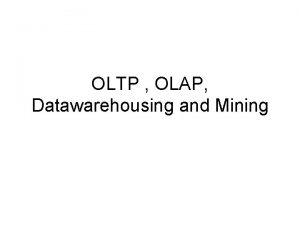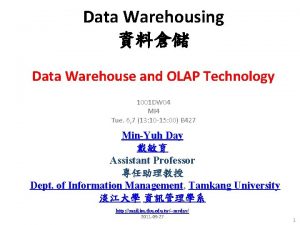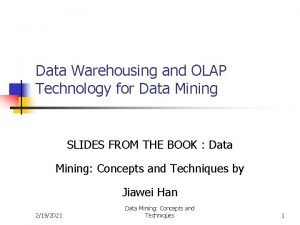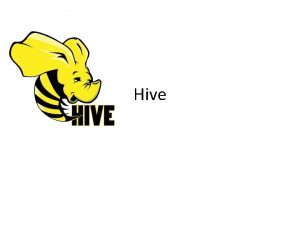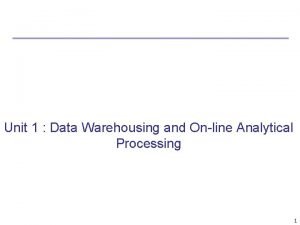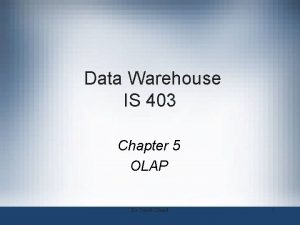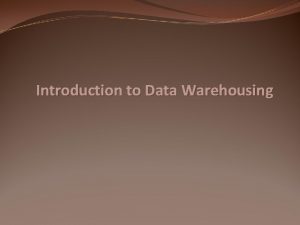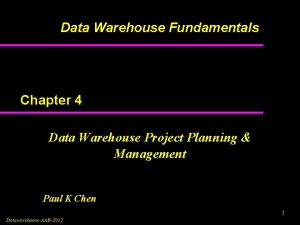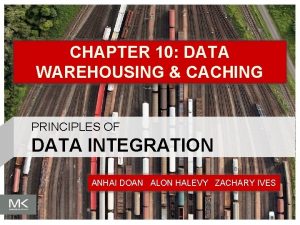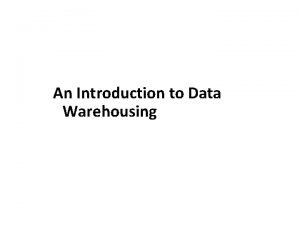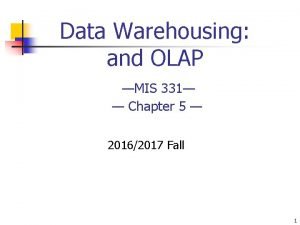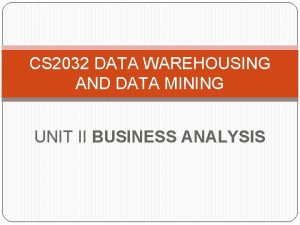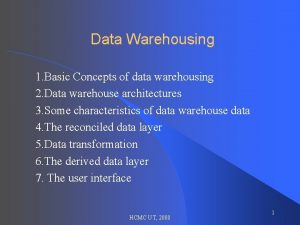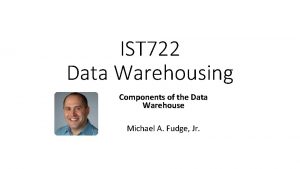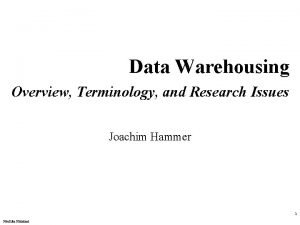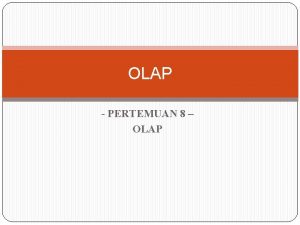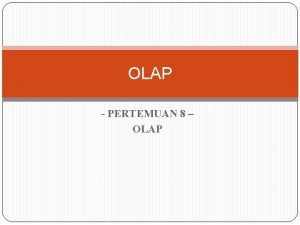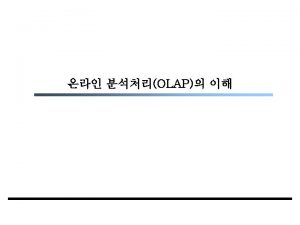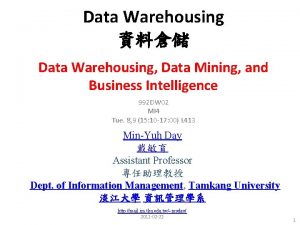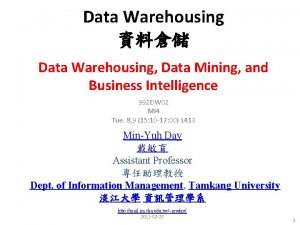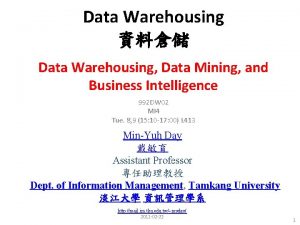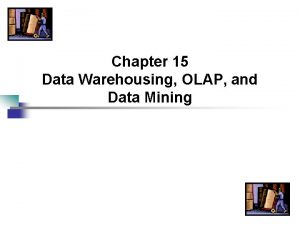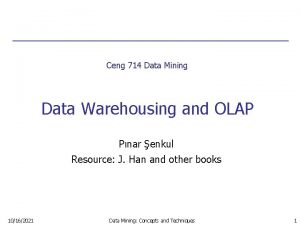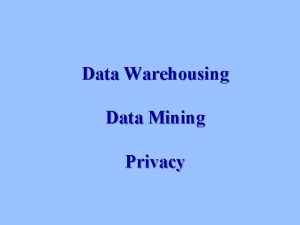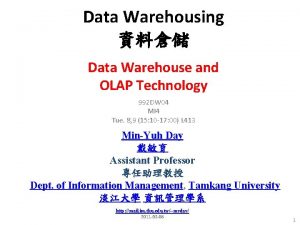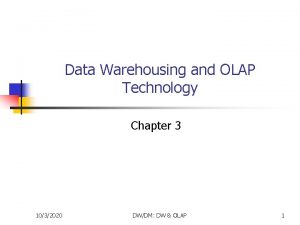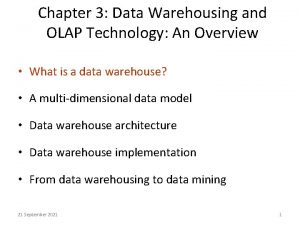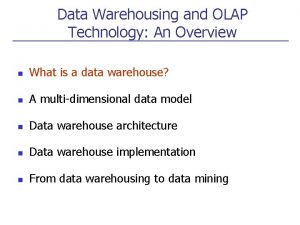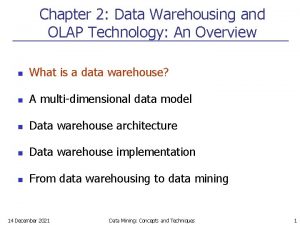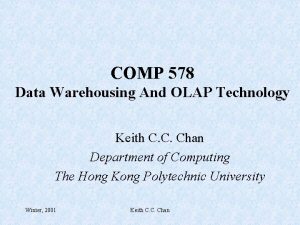Data Warehousing and OLAP Technology for Data Mining
































- Slides: 32

Data Warehousing and OLAP Technology for Data Mining SLIDES FROM THE BOOK : Data Mining: Concepts and Techniques by Jiawei Han 2/19/2021 Data Mining: Concepts and Techniques 1

Data Warehousing and OLAP Technology for Data Mining n What is a data warehouse? n A multi-dimensional data model n Data warehouse architecture n Data warehouse implementation n Further development of data cube technology n From data warehousing to data mining 2/19/2021 Data Mining: Concepts and Techniques 2

What is Data Warehouse? n n n 2/19/2021 Defined in many different ways, but not rigorously. n A decision support database that is maintained separately from the organization’s operational database n Support information processing by providing a solid platform of consolidated, historical data for analysis. “A data warehouse is a subject-oriented, integrated, time -variant, and nonvolatile collection of data in support of management’s decision-making process. ”—W. H. Inmon Data warehousing: n The process of constructing and using data warehouses Data Mining: Concepts and Techniques 3

Data Warehouse—Subject-Oriented n Organized around major subjects, such as customer, product, sales. n Focusing on the modeling and analysis of data for decision makers, not on daily operations or transaction processing. n Provide a simple and concise view around particular subject issues by excluding data that are not useful in the decision support process. 2/19/2021 Data Mining: Concepts and Techniques 4

Data Warehouse—Integrated n n Constructed by integrating multiple, heterogeneous data sources n relational databases, flat files, on-line transaction records Data cleaning and data integration techniques are applied. n Ensure consistency in naming conventions, encoding structures, attribute measures, etc. among different data sources n n 2/19/2021 E. g. , Hotel price: currency, tax, breakfast covered, etc. When data is moved to the warehouse, it is converted. Data Mining: Concepts and Techniques 5

Data Warehouse—Time Variant n The time horizon for the data warehouse is significantly longer than that of operational systems. n n n Data warehouse data: provide information from a historical perspective (e. g. , past 5 -10 years) Every key structure in the data warehouse n n 2/19/2021 Operational database: current value data. Contains an element of time, explicitly or implicitly But the key of operational data may or may not contain “time element”. Data Mining: Concepts and Techniques 6

Data Warehouse—Non-Volatile n A physically separate store of data transformed from the operational environment. n Operational update of data does not occur in the data warehouse environment. n Does not require transaction processing, recovery, and concurrency control mechanisms n Requires only two operations in data accessing: n 2/19/2021 initial loading of data and access of data. Data Mining: Concepts and Techniques 7

Data Warehouse vs. Heterogeneous DBMS n Traditional heterogeneous DB integration: n Build wrappers/mediators on top of heterogeneous databases n Query driven approach n n n Complex information filtering, compete for resources Data warehouse: update-driven, high performance n 2/19/2021 When a query is posed to a client site, a meta-dictionary is used to translate the query into queries appropriate for individual heterogeneous sites involved, and the results are integrated into a global answer set Information from heterogeneous sources is integrated in advance and stored in warehouses for direct query and analysis Data Mining: Concepts and Techniques 8

Data Warehouse vs. Operational DBMS n OLTP (on-line transaction processing) n n 2/19/2021 Major task of traditional relational DBMS Day-to-day operations: purchasing, inventory, banking, manufacturing, payroll, registration, accounting, etc. OLAP (on-line analytical processing) n Major task of data warehouse system n Data analysis and decision making Distinct features (OLTP vs. OLAP): n User and system orientation: customer vs. market n Data contents: current, detailed vs. historical, consolidated n Database design: ER + application vs. star + subject n View: current, local vs. evolutionary, integrated n Access patterns: update vs. read-only but complex queries Data Mining: Concepts and Techniques 9

OLTP vs. OLAP 2/19/2021 Data Mining: Concepts and Techniques 10

Why Separate Data Warehouse? n n High performance for both systems n DBMS— tuned for OLTP: access methods, indexing, concurrency control, recovery n Warehouse—tuned for OLAP: complex OLAP queries, multidimensional view, consolidation. Different functions and different data: n missing data: Decision support requires historical data which operational DBs do not typically maintain n data consolidation: DS requires consolidation (aggregation, summarization) of data from heterogeneous sources n data quality: different sources typically use inconsistent data representations, codes and formats which have to be reconciled 2/19/2021 Data Mining: Concepts and Techniques 11

Chapter 2: Data Warehousing and OLAP Technology for Data Mining n What is a data warehouse? n A multi-dimensional data model n Data warehouse architecture n Data warehouse implementation n Further development of data cube technology n From data warehousing to data mining 2/19/2021 Data Mining: Concepts and Techniques 12

From Tables and Spreadsheets to Data Cubes n n A data warehouse is based on a multidimensional data model which views data in the form of a data cube A data cube, such as sales, allows data to be modeled and viewed in multiple dimensions n n n 2/19/2021 Dimension tables, such as item (item_name, brand, type), or time(day, week, month, quarter, year) Fact table contains measures (such as dollars_sold) and keys to each of the related dimension tables In data warehousing literature, an n-D base cube is called a base cuboid. The top most 0 -D cuboid, which holds the highest-level of summarization, is called the apex cuboid. The lattice of cuboids forms a data cube. Data Mining: Concepts and Techniques 13

Cube: A Lattice of Cuboids all time, item 0 -D(apex) cuboid item time, location item, location time, supplier time, item, location supplier location, supplier item, supplier time, location, supplier time, item, supplier 1 -D cuboids 2 -D cuboids 3 -D cuboids item, location, supplier 4 -D(base) cuboid time, item, location, supplier 2/19/2021 Data Mining: Concepts and Techniques 14

Conceptual Modeling of Data Warehouses n Modeling data warehouses: dimensions & measures n Star schema: A fact table in the middle connected to a set of dimension tables n Snowflake schema: A refinement of star schema where some dimensional hierarchy is normalized into a set of smaller dimension tables, forming a shape similar to snowflake n Fact constellations: Multiple fact tables share dimension tables, viewed as a collection of stars, therefore called galaxy schema or fact constellation 2/19/2021 Data Mining: Concepts and Techniques 15

Example of Star Schema time item time_key day_of_the_week month quarter year Sales Fact Table time_key item_key branch_key branch_name branch_type location_key units_sold dollars_sold avg_sales item_key item_name brand type supplier_type location_key street city province_or_state country Measures 2/19/2021 Data Mining: Concepts and Techniques 16

Example of Snowflake Schema time_key day_of_the_week month quarter year item Sales Fact Table time_key item_key branch location_key branch_name branch_type units_sold dollars_sold avg_sales Measures 2/19/2021 Data Mining: Concepts and Techniques item_key item_name brand type supplier_key supplier_type location_key street city_key city province_or_state country 17

Example of Fact Constellation time_key day_of_the_week month quarter year item Sales Fact Table time_key item_key item_name brand type supplier_type location_key branch_name branch_type units_sold dollars_sold avg_sales item_key shipper_key location to_location_key street city province_or_state country dollars_cost Measures 2/19/2021 time_key from_location branch_key branch Shipping Fact Table Data Mining: Concepts and Techniques units_shipped shipper_key shipper_name location_key shipper_type 18

Measures: Three Categories n distributive: if the result derived by applying the function to n aggregate values is the same as that derived by applying the function on all the data without partitioning. n n algebraic: if it can be computed by an algebraic function with M arguments (where M is a bounded integer), each of which is obtained by applying a distributive aggregate function. n n E. g. , count(), sum(), min(), max(). E. g. , avg(), min_N(), standard_deviation(). holistic: if there is no constant bound on the storage size needed to describe a subaggregate. n 2/19/2021 E. g. , median(), mode(), rank(). Data Mining: Concepts and Techniques 19

A Concept Hierarchy: Dimension (location) all Europe region country city office 2/19/2021 Germany Frankfurt . . Spain North_America Canada Vancouver. . . L. Chan . . . Data Mining: Concepts and Techniques . . . Mexico Toronto M. Wind 20

View of Warehouses and Hierarchies Specification of hierarchies n Schema hierarchy day < {month < quarter; week} < year n Set_grouping hierarchy {1. . 10} < inexpensive 2/19/2021 Data Mining: Concepts and Techniques 21

Multidimensional Data Sales volume as a function of product, month, and region Dimensions: Product, Location, Time Hierarchical summarization paths gi on n Re Industry Region Year Product Category Country Quarter Product City Office Month Week Day Month 2/19/2021 Data Mining: Concepts and Techniques 22

2 Qtr 3 Qtr 4 Qtr Total annual sales sum of TV in U. S. A. od TV PC VCR sum 1 Qtr Date Pr U. S. A Canada Mexico Country uc t A Sample Data Cube sum 2/19/2021 Data Mining: Concepts and Techniques 23

Cuboids Corresponding to the Cube all 0 -D(apex) cuboid product, date country product, country 1 -D cuboids date, country 2 -D cuboids product, date, country 2/19/2021 Data Mining: Concepts and Techniques 3 -D(base) cuboid 24

Browsing a Data Cube n n n 2/19/2021 Visualization OLAP capabilities Interactive manipulation Data Mining: Concepts and Techniques 25

Typical OLAP Operations n Roll up (drill-up): summarize data n n Drill down (roll down): reverse of roll-up n n reorient the cube, visualization, 3 D to series of 2 D planes. Other operations n n 2/19/2021 project and select Pivot (rotate): n n from higher level summary to lower level summary or detailed data, or introducing new dimensions Slice and dice: n n by climbing up hierarchy or by dimension reduction drill across: involving (across) more than one fact table drill through: through the bottom level of the cube to its backend relational tables (using SQL) Data Mining: Concepts and Techniques 26

Chapter 2: Data Warehousing and OLAP Technology for Data Mining n What is a data warehouse? n A multi-dimensional data model n Data warehouse architecture n Data warehouse implementation n Further development of data cube technology n From data warehousing to data mining 2/19/2021 Data Mining: Concepts and Techniques 27

Design of a Data Warehouse: A Business Analysis Framework n Four views regarding the design of a data warehouse n Top-down view n n Data source view n n consists of fact tables and dimension tables Business query view n 2/19/2021 exposes the information being captured, stored, and managed by operational systems Data warehouse view n n allows selection of the relevant information necessary for the data warehouse sees the perspectives of data in the warehouse from the view of end-user Data Mining: Concepts and Techniques 28

Multi-Tiered Architecture other Metadata sources Operational DBs Extract Transform Load Refresh Monitor & Integrator Data Warehouse OLAP Server Serve Analysis Query Reports Data mining Data Marts Data Sources 2/19/2021 Data Storage OLAP Engine Front-End Tools Data Mining: Concepts and Techniques 29

Three Data Warehouse Models n n Enterprise warehouse n collects all of the information about subjects spanning the entire organization Data Mart n a subset of corporate-wide data that is of value to a specific groups of users. Its scope is confined to specific, selected groups, such as marketing data mart n n Independent vs. dependent (directly from warehouse) data mart Virtual warehouse n A set of views over operational databases n Only some of the possible summary views may be materialized 2/19/2021 Data Mining: Concepts and Techniques 30

Data Warehouse Development: A Recommended Approach Multi-Tier Data Warehouse Distributed Data Marts Data Mart Model refinement Enterprise Data Warehouse Model refinement Define a high-level corporate data model 2/19/2021 Data Mining: Concepts and Techniques 31

OLAP Server Architectures n n Relational OLAP (ROLAP) n Use relational or extended-relational DBMS to store and manage warehouse data and OLAP middle ware to support missing pieces n Include optimization of DBMS backend, implementation of aggregation navigation logic, and additional tools and services n greater scalability Multidimensional OLAP (MOLAP) n Array-based multidimensional storage engine (sparse matrix techniques) n fast indexing to pre-computed summarized data Hybrid OLAP (HOLAP) n User flexibility, e. g. , low level: relational, high-level: array Specialized SQL servers n specialized support for SQL queries over star/snowflake schemas 2/19/2021 Data Mining: Concepts and Techniques 32
 Olap data mining
Olap data mining Chicago time
Chicago time An overview of data warehousing and olap technology
An overview of data warehousing and olap technology What is kdd process in data mining
What is kdd process in data mining Datamart olap
Datamart olap Introduction to data warehousing and data mining
Introduction to data warehousing and data mining Olap vs oltp in data mining
Olap vs oltp in data mining Data warehouse and olap technology
Data warehouse and olap technology Data warehouse and olap technology
Data warehouse and olap technology Mining complex types of data in data mining
Mining complex types of data in data mining Data cube technology in data mining
Data cube technology in data mining Mining multimedia databases in data mining
Mining multimedia databases in data mining Difference between strip mining and open pit mining
Difference between strip mining and open pit mining Difference between text mining and web mining
Difference between text mining and web mining Hive provides data warehousing layer to data over hadoop
Hive provides data warehousing layer to data over hadoop Data warehouse design best practices
Data warehouse design best practices Strip mining vs open pit mining
Strip mining vs open pit mining Strip mining vs open pit mining
Strip mining vs open pit mining Starnet query model in data warehouse
Starnet query model in data warehouse Rolap
Rolap Different olap architectures
Different olap architectures Introduction to data warehouse
Introduction to data warehouse Greenplum data warehousing
Greenplum data warehousing Data warehouse component
Data warehouse component Data warehouse project plan
Data warehouse project plan Temporal parallelism
Temporal parallelism Principles of data warehouse
Principles of data warehouse Introduction of data warehouse
Introduction of data warehouse Concept hierarchy in data warehousing
Concept hierarchy in data warehousing Cognos impromptu in data warehousing
Cognos impromptu in data warehousing Basic concept of data warehousing
Basic concept of data warehousing Data warehousing components
Data warehousing components Query driven approach in data warehouse
Query driven approach in data warehouse






